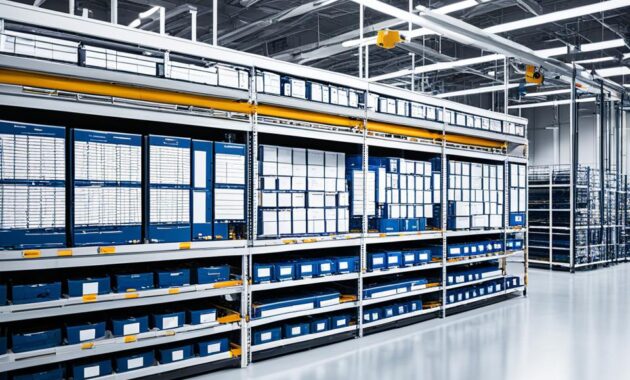In today’s competitive manufacturing landscape, businesses are constantly seeking ways to streamline their operations, enhance productivity, and respond swiftly to evolving market demands. One strategic approach that has gained widespread recognition is Manufacturing Resource Planning (MRP). This comprehensive system integrates production, inventory, and capacity planning to help organizations make more informed decisions, improve responsiveness, and drive continuous improvement.
At the heart of MRP lies the goal of optimizing production and resource allocation. By leveraging data-driven insights, manufacturers can achieve greater efficiency, reduce waste, and enhance their overall competitiveness. This article will delve into the core principles of MRP, its key benefits, and the strategies businesses can adopt to implement it effectively and unlock the full potential of their manufacturing operations.
Key Takeaways
- Manufacturing Resource Planning (MRP) is a strategic approach that integrates production, inventory, and capacity planning to optimize manufacturing operations.
- MRP helps businesses make better-informed decisions, improve responsiveness to market demands, and drive continuous improvement.
- By implementing MRP, organizations can achieve greater efficiency, reduce waste, and enhance their overall competitiveness.
- Effective MRP implementation requires a comprehensive understanding of its core principles and the adoption of proven strategies for inventory management and supply chain integration.
- Integrating MRP with enterprise-wide systems, such as ERP, can further enhance the efficiency and visibility of manufacturing processes.
What is Manufacturing Resource Planning?
Manufacturing Resource Planning (MRP) is a comprehensive system that integrates and automates the planning of production, inventory, and capacity. At its core, MRP focuses on three key principles: material requirements planning, capacity planning, and production scheduling.
Definition and Core Principles
The manufacturing resource planning definition encompasses the strategic alignment of an organization’s resources, including materials, equipment, and labor, to meet production demands efficiently. MRP aims to ensure that the right materials are available at the right time, in the right quantities, to support the manufacturing process.
The core principles of MRP include:
- Material Requirements Planning: Determining the specific materials, components, and raw materials required to fulfill production orders based on a master production schedule.
- Capacity Planning: Assessing the available manufacturing capacity, including equipment, labor, and facilities, to ensure that production can be executed within the required time frame.
- Production Scheduling: Developing a detailed plan for the timing and sequencing of production activities to optimize efficiency and minimize downtime.
Benefits of MRP Implementation
By implementing a robust manufacturing resource planning system, businesses can reap numerous benefits, including:
- Improved Inventory Management: MRP helps organizations maintain optimal inventory levels, reducing the risk of stockouts or overstocking.
- Reduced Lead Times: Efficient material requirements planning and production scheduling can significantly shorten the time required to fulfill customer orders.
- Enhanced Production Efficiency: Effective capacity planning and production scheduling can help organizations maximize their manufacturing output and minimize waste.
- Better Alignment Between Supply and Demand: MRP enables businesses to closely match their production capabilities with customer demand, minimizing the risk of imbalances.
| Key MRP Components | Descriptions |
|---|---|
| Material Requirements Planning | Determines the specific materials, components, and raw materials required to fulfill production orders based on a master production schedule. |
| Capacity Planning | Assesses the available manufacturing capacity, including equipment, labor, and facilities, to ensure that production can be executed within the required time frame. |
| Production Scheduling | Develops a detailed plan for the timing and sequencing of production activities to optimize efficiency and minimize downtime. |
Key Components of Manufacturing Resource Planning
Manufacturing Resource Planning (MRP) is a comprehensive system that encompasses several interconnected components, each playing a crucial role in optimizing production and resource utilization. These key components include material requirements planning, capacity requirements planning, production scheduling, and inventory management.
At the heart of MRP is material requirements planning, which determines the specific materials and components needed to fulfill production orders. This system analyzes customer demand, inventory levels, and lead times to generate a detailed plan for procuring the necessary raw materials and parts.
Capacity requirements planning is another vital component of MRP, focusing on ensuring that the manufacturing facility has the necessary production capacity to meet the planned output. This involves analyzing machine and labor capacity, identifying bottlenecks, and adjusting the production schedule accordingly.
Production scheduling is the process of creating a detailed plan for the manufacturing process, taking into account the availability of materials, equipment, and labor. This component of MRP helps to optimize the flow of production, minimize downtime, and meet customer delivery targets.
Finally, inventory management plays a crucial role in MRP, as it ensures that the right amounts of materials and finished goods are available at the right time. This component helps to minimize excess inventory, reduce waste, and maintain a lean, efficient supply chain.
By seamlessly integrating these key components, MRP provides a comprehensive and data-driven approach to manufacturing, enabling businesses to optimize their production processes, reduce costs, and better respond to customer demands.
| MRP Component | Description |
|---|---|
| Material Requirements Planning | Determines the specific materials and components needed to fulfill production orders |
| Capacity Requirements Planning | Ensures that the manufacturing facility has the necessary production capacity to meet the planned output |
| Production Scheduling | Creates a detailed plan for the manufacturing process, taking into account the availability of materials, equipment, and labor |
| Inventory Management | Ensures that the right amounts of materials and finished goods are available at the right time |

Strategies for Optimizing Manufacturing Resource Planning
To maximize the benefits of Manufacturing Resource Planning (MRP), businesses can implement a range of advanced strategies. From data-driven inventory management techniques to comprehensive supply chain integration, these optimization methods can help organizations streamline their operations, minimize waste, and enhance responsiveness to customer demands.
Inventory Management Techniques
Effective inventory management is a crucial component of MRP optimization. By leveraging just-in-time (JIT) and kanban systems, companies can minimize excess stock, reduce carrying costs, and improve their ability to meet changing customer requirements. These data-driven approaches to inventory management enable businesses to align their production schedules more closely with actual demand, leading to increased efficiency and reduced waste.
Supply Chain Integration
Integrating MRP with other enterprise systems and supply chain partners can further enhance the efficiency of manufacturing resource planning. By improving visibility across the entire supply chain, organizations can streamline processes, eliminate bottlenecks, and drive continuous improvements in manufacturing performance. This level of supply chain integration enables better demand forecasting, production scheduling, and overall coordination, ultimately leading to a more responsive and resilient manufacturing ecosystem.
| Inventory Management Strategies | Supply Chain Integration Benefits |
|---|---|
|
|
By implementing these strategies for manufacturing resource planning optimization, businesses can unlock the full potential of MRP, driving operational excellence, cost savings, and improved customer satisfaction.
Conclusion
Manufacturing Resource Planning (MRP) is a transformative approach that empowers businesses to optimize their production, streamline inventory management, and enhance overall manufacturing efficiency. By integrating critical components such as production planning, material requirements, capacity planning, and inventory control, MRP enables organizations to make data-driven decisions, respond swiftly to market changes, and achieve operational excellence.
Through the implementation of effective MRP strategies, businesses can enhance their manufacturing resource planning benefits, drive production optimization, maintain tight inventory control, and improve supply chain efficiency. This comprehensive approach equips companies with the tools and insights necessary to make informed decisions, boost customer satisfaction, and ultimately, achieve sustainable long-term growth.
As the manufacturing landscape continues to evolve, the adoption of manufacturing resource planning will be pivotal in empowering organizations to stay ahead of the curve, capitalize on emerging opportunities, and cement their position as industry leaders. By embracing the transformative power of MRP, businesses can unlock new levels of operational excellence and position themselves for continued success in the ever-changing manufacturing landscape.

